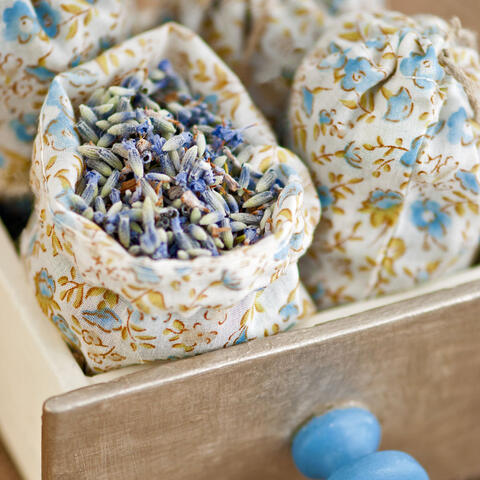How to make lavender tea
Experience the healing and relaxing effects of Lavender by having some Lavender tea. Make yourself some Lavender tea.

Lavender tea is easy to make and has a wonderfully relaxing effect on the body
Lavender tea has anti-inflammatory, antispasmodic effects and aids blood circulation. At the same time, lavender tea has a relaxing and calming effect on the entire being. It is considered a proven home remedy and is mainly used for the following complaints:
- Gas and bloating
- Stomach ache
- Stomach cramps
- Indigestion
- Headache
- Poor concentration
- Tooth ache
- Insomnia
- Restlessness
- Circulatory problems
As a medicinal plant, English Lavender (Lavandula angustifolia) was valued by the Romans who also used to perfume their bathing water. Lavender also plays an important role in monastic medicine. Lavender tea has not lost its importance as a health-promoting tea till this day. The reason for this is the valuable ingredients of lavender, which include essential oils in high concentrations, but also many tanning agents, bitter substances, flavonoids and saponins.
You can make Lavender tea yourself in no time. The key ingredient: Lavender blossoms. Preferably use organic plant parts from your own garden, if possible.
For a cup of lavender tea you need:
- A tea infuser or a tea filter
- Cup
- 2 full teaspoons of lavender flowers
- 250 milliliters of boiling water
Put full teaspoons of Lavender flowers into a tea infuser or tea filter and then into a cup. Pour a quarter liter of boiling water into the cup and cover it for eight to ten minutes. Now, enjoy your homemade lavender tea - and relax.

Tip: If the floral soapy taste of lavender tea is not to your liking, you can sweeten the tea with honey or mix it with other types of tea. For example, teas made from rose petals , chamomile, lime blossoms or licorice are suitable. Also, valerian or St. John’s wort go well with lavender tea and they also improve its balancing effect.
Drinking lavender tea throughout the day and having small sips after eating relieves above all discomfort in the abdomen. Drinking lavender tea before sleeping has a calming effect and it improves your sleep. Despite its health benefits adults should not have more than two to three cups of lavender tea a day. Pregnant women should also consult their doctor before consuming lavender tea, even if side effects are next to none.
Consuming lavender in the form of tea is only one of the several possibilities of benefiting from the soothing effect of the medicinal plant. Especially in the field of natural cosmetics there are countless products containing lavender. A wide variety of relaxing baths, oils, creams, soaps and perfumes are also available.

Lavender is also often used in cooking. Not only does lavender enhance the flavor of the Provencal cuisine but it also elevates dishes with vegetables, meat and fish. And lavender flowers add a touch of sophistication to desserts and sauces. However, it should be noted that lavender - whether fresh or dried - should be used sparingly because its distinctive aroma would otherwise overshadow other spices
Lavender can grow in our climate without any problems. It thrives well in a pot on the terrace or even in the garden. It is also reassuringly easy to care for. Simply choose a sunny and warm place with sandy-gravelly, dry and nutrient-poor soil for the Mediterranean plant. Winter protection is only required in very cold regions or in places experiencing frost for a long time. Container plants should be watered sparingly, lavender in the flower bed should be watered only if it remains dry for a long time. In order to keep lavender thriving for many years, it is recommended to prune the lavender every year in spring.



